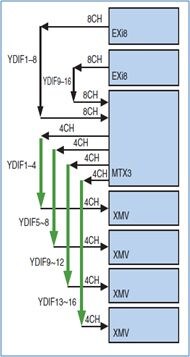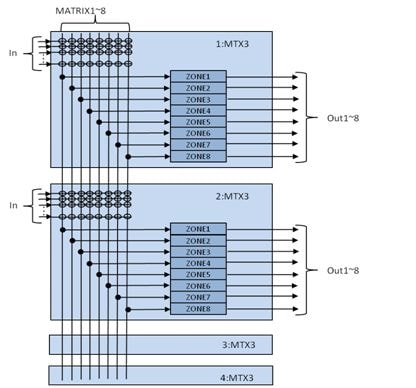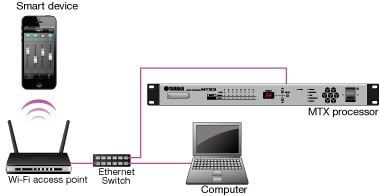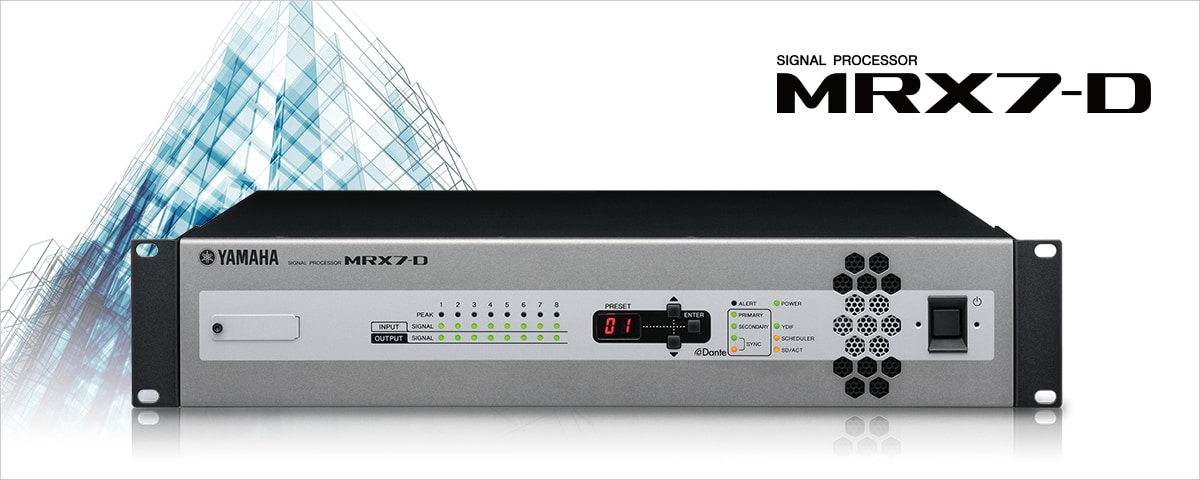MRX7-D
Network Audio
What does YDIF mean?
YDIF is an abbreviation for Yamaha Digital InterFace. It is a proprietary sound transmission format for sending and receiving audio streams (total 16-channels) and wordclock via an Ethernet cable. The physical connections use a ring topography. YDIF can be used to connect rack mounted devices simply and easily. Control signals are not sent using YDIF but via a separate network port.
What is the maximum cable length that can be used with YDIF?
The maximum length of cable that can be used to connect devices using YDIF is 30m. Since up to 8 devices can be connected using YDIF, the total length of cable used can be up to 240 m (30 m x 8). However, this does not mean that two connected devices can be spaced 240 m apart, since devices are connected in a ring configuration.
Note:
Since YDIF is a proprietary Yamaha standard, it is not possible to increase this distance using a network switch.
What cable should I use to connect up YDIF?
Please use an 8-pin straight STP (shielded twisted-pair) Ethernet cable of Cat-5e or above.
What is the Distribution Mode on the YDIF?
Distribution Mode
In Distribution Mode, the default, up to 16 channels of audio signals are transferred in one direction — between multiple devices equipped with YDIF (MTX, MRX, EXi8, EXo8, and XMV), which are connected in ring connection. A single audio signal can be distributed to multiple devices.
Usage example:
The benefits of YDIF compared with analogue transmission is that audio signals are sent to XMV Series power amplifiers without any deterioration in sound quality, and cabling costs and labour costs are reduced.

What is the Cascade Mode on the YDIF?
Cascade Mode
Cascade Mode allows up to eight matrix bus channels of multiple MTX processors to be shared. By ring connecting up to four MTX processors, up to 32 channels of microphones can be connected and 8 shared mixes created. The 8 mixes can be used on all MTX processors, allowing up to 32 output channels. Only MTX processors can be connected in Cascade Mode with YDIF. Note that selection of distribution or cascade mode is made per device. Transmission to XMV amplifiers is always made in distribution mode.
Usage example:
Multiple MTX3 are connected in cascade mode to increase input channels.

How many devices (e.g. MTX3, MTX5-D, MRX7-D, EXi8, EXo8, and XMV amplifiers) with YDIF connectivity can be connected together?
Up to eight devices equipped with YDIF can be connected in Distribution Mode. However, at least one MTX/MRX processor must be included. Up to four MTX processors can be connected in Cascade Mode. However, only MTX processors can be connected in this mode.
Can a Dante-compatible device, such as an MTX5-D, MRX7-D, XMV4140-D, or XMV4280-D, exchange audio signals with another Dante-compatible device?
It is possible to transmit audio signals between a Dante-compatible device and other Dante devices, such as a CL Series digital mixing console or a Dante MY16-AUD card, via a Dante network by setting up routing using Dante controller.
Do Dante enabled devices such as MTX5-D, MRX7-D and XMV-D require separate Ethernet cables to exchange control signals and audio signals?
Since the control signal and the audio signal are transferred using a single Ethernet cable in Dante, it is not necessary to have separate Ethernet cables for the control signal and the audio signal.
Is it possible to control the head amp of an external device (such as an EXi8 or a Rio3224-D) using MTX-MRX Editor?
If you use an EXi8 in conjunction with a MTX/MRX processor, you can control the EXi8's head amp using MTX-MRX Editor. However, the head amp of an I/O device such as a Rio Series device cannot be controlled using MTX-MRX Editor. In that case, R Remote software would be necessary.
Is it possible for other Yamaha devices (aside from MTX3, MTX5-D and MRX7-D) to control the head amp of MTX/MRX series devices (EXi8, MTX3, MTX5-D, MRX7-D)?
No, other Yamaha devices aside from MTX3, MTX5-D and MRX7-D do not have this ability.
General Specification
Which types and formats of SD memory card can be used with an MTX/MRX processor?
File system format: FAT32, FAT16, FAT12
Storage capacity: SDHC: up to 32 GB (FAT32)
SD: up to 2 GB (FAT16)
Which audio file formats can be played back on the SD card player?
WAV: 16-bit 2-ch PCM
sampling frequencies:
8 kHz, 16 kHz, 32 kHz, 11.025 kHz, 22.05 kHz, 44.1 kHz, 12 kHz, 24 kHz, and 48 kHz
MP3: MPEG-1/2/2.5 Audio Layer-3
sampling frequencies:
MPEG-1: 32 kHz, 44.1 kHz, and 48 kHz
MPEG-2: 16 kHz, 22.05 kHz, and 24 kHz
MPEG-2.5: 8 kHz and 11.025 kHz
What is an AGC (auto gain controller)?
The AGC (auto gain controller) function automatically corrects the gain in accordance with the level of the input, so as to achieve a constant output signal level from input signals of varying levels. For example, when a single microphone is used by several people, the microphone position and voice amplitude will vary from person to person. The differences in volume when the sound is amplified make things difficult for the listener. In this type of instance the AGC can be used to maintain the amplified sound at a constant volume. Alternatively, when several CDs with different recording levels are being used for background music, turning on the AGC will enable the output to be maintained at a constant level, obviating the need to adjust the output level by hand every time the CD is changed.
Unlike a compressor function which can only reduce level, an AGC can also increase level.
What is an ANC (ambient noise compensator)?
The ANC (ambient noise compensator) function increases and decreases the output signal from an MTX/MRX processor in accordance with the signal level input from a microphone that measures ambient noise. The ANC on an MTX/MRX processor detects sections in which there is no sound (such as the gap between songs), measures the noise level during these gaps, and increases or decreases the output signal using the measured noise level as the standard noise level. This is known as a gap-type ANC. For example, if the noise at a party venue turns out to be louder than expected, it may be that the preset volume level on the MC's microphone will be insufficient. If the noise at the party is loud, the ANC will increase the volume level on the MC's microphone accordingly, so that the MC can be clearly heard by the attendees, despite the noise at the venue.
What is an FBS (feedback suppressor)?
The FBS (feedback suppressor) function can prevent unpleasant feedback noises that occur when the sound from the loudspeakers feed back into the microphone. As well as being unpleasant or even painful on the listeners' ears, this can also damage the speakers in certain circumstances. To prevent feedback noise, a certain distance should be maintained between the speakers and the microphone, so that the microphone will not pick up the sound output by the speakers. If feedback still persists, despite this distance, use the FBS function to improve the feedback margin. This will inhibit the feedback, enabling you to increase the output volume.
Can an FBS (feedback suppressor) automatically detect the feedback frequency?
The FBS (feedback suppressor) function eliminates unpleasant feedback frequencies by applying notch filters to them. The FBS on an MTX/MRX processor has a function that enables it to detect feedback frequencies automatically.
Select the type of filter to apply to the detected frequency according to whether it is fixed or dynamic in nature (as described below).
Fixed
Method in which the feedback point in the hall where the speakers and microphone are located is detected in advance and the filter is set up at this point. Good for a fixed-position microphone.
Dynamic
Method in which a filter is applied that follows the wavelength of a constantly changing feedback point. Good for a wireless microphone that is used in different positions and thus cannot be confined to a single location.
Applying a dynamic FBS as well as a fixed FBS to a fixed-position microphone will serve to suppress feedback if you are holding the microphone or covering it with your hand.
Can Preset Recall be used to make multiple MTX/MRX processors operate in conjunction with one another?
Yes. If a system is comprised of multiple MTX/MRX processors and the presets on one of the processors are recalled, the presets for all the other processors corresponding to the same preset number are also recalled. Since the presets on an MTX/MRX processor can also include settings for EXi8s, EXo8s, and XMV Series amplifiers, a Preset Recall will also change the settings on any of these devices if they are part of the system—as well as the settings on any other MTX/MRX processor within the system.
What operations can I perform from the front panel on an MTX/MRX processor?
You can perform a Preset Recall from the front panel. To perform any other operations, use MTX-MRX Editor or a controller such as a DCP controller, Wireless DCP, or GPI.
Is the 8-channel mic/line (analog Euroblock) input on an MTX/MRX processor equipped with phantom power?
Each channel is internally supplied with +48 V of phantom power.You can turn phantom power on or off for each channel using MTX-MRX Editor. There is no master switch for phantom power, however.
Is it possible to control an MTX/MRX processor using MIDI signals from an external controller?
It is not possible to control an MTX/MRX processor using MIDI signals. However, you can control an MTX/MRX processor remotely using a GPI or DCP controller, Wireless DCP or ProVisionaire Touch iPhone application, or third-party external controllers such as AMX or Crestron controllers.
* For details, please refer to "MTX3, MTX5-D, MRX7-D, XMV Series, EXi8, EXo8 remote control protocol specifications"
What is the required operating environment for MTX-MRX Editor?
OS: Windows 7 Home Premium or above, Windows 8, Windows 10
CPU: Core i3/5 or above
RAM: at least 4 GB
HDD: at least 150 MB of free space
Display: over 1024 x 768 pixels
* Requires the installation of Bonjour by Apple.
Is it possible to control an MTX/MRX processor using an AMX or Crestron touch screen panel?
It is possible to carry out remote operations such as MTX/MRX processor Preset Recall and controlling MTX/MRX processor parameters from an external controller such as an AMX or Crestron controller via a network (TCP/IP) port or remote (RS-232C) port.
* For details, please refer to "MTX3, MTX5-D, MRX7-D, XMV Series, EXi8, EXo8 remote control protocol specifications"
What is the RS-232C port used for?
The RS-232C remote port allows remote operation of the MTX/MRX processor from an AMX or Crestron controller. Remote operation will also be possible via a network (TCP/IP) port.
Can I use the data created by MTX Editor on MTX-MRX Editor?
Yes. It is possible.
However, the data created on MTX-MRX Editor can not be used on MTX Editor.
Can I export the configuration data from MRX with MTX-MRX Editor?
Yes. It is possible.
All component and connection data on the MRX device can be retrieved without the Project file, by using the Go Online - From devices function.
Is there a security function on MTX-MRX Editor?
It is possible to set a password (pin code) to protect important data from being maliciously edited or stolen.
Is it possible to control MRX/MTX/XMV through the Internet with MTX-MRX Editor?
It is not possible to control MRX/MTX/XMV through the Internet with MTX-MRX Editor.
Is it possible to adjust the delay time on output channels?
The delay time on output channels is adjusted automatically.
The delay time of audio inputs to components is adjusted automatically to align the outputs.
Total delay time can be checked with the POPUP after compiling.
What is the maximum number of I/O in a Matrix Mixer component?
The largest size of Matrix Mixer is 64in x 64out.
DCP
How many DCP control panels can be connected?
Eight DCP controllers can be connected to a single MTX/MRX processor. Up to 4 MTX/MRX processors can be used in a single system, meaning up to 32 DCP controllers can be connected in total within a single system.
What is the greatest distance at which a DCP control panel can be connected to an MTX/MRX processor?
It is possible to connect up to eight units of DCP controller by using daisy chain connections of up to 200m. And, it ispossible to extend the connection distance by reducing the number of DCP series that are installed as below.

Is it possible to control multiple MTX/MRX processors within a system from a DCP or GPI controller, or from Wireless DCP?
Yes.
Since control commands issued by a DCP controller, a GPI controller, or Wireless DCP can be sent to any MTX/MRX processor within the system, a single controller can be used to control multiple MTX/MRX processors.
DCH8
How many devices can we connect to host devices such asMTX series or MRX7-D?
Maximum number of device connections per host is below.

Is it possible to connect to any Network Switches?
No it is not possible.You can only connect to DCP series and MTX/MRX series.
Wireless DCP
What can be done with the Wireless DCP iPhone application?
Using the Wireless DCP iPhone application you can perform the same operations as with a DCP controller (change the parameter settings on an MTX/MRX processor, perform a Preset Recall, and play back files stored on an SD card) via Wi-Fi from the touchscreen of your iPhone or iPad. You can even operate faders (which are not featured on a DCP controller).
How should I connect the network devices in order to control the MTX/MRX processor using the Wireless DCP iPhone application?
Connect a Wi-Fi access point to your MTX/MRX processor using a Cat-5e cable and set an IP address on your iOS device (such as iPhone). If necessary, connect an Ethernet switch between the access point and the processor.

How many remote controllers (Wireless DCP, ProVisionaire Touch, AMX/Crestron) can be used with one MTX/MRX?
The maximum number of remote controllers that can be connected to one unit of MTX/MRX is 8, including Wireless DCP, ProVisionaire Touch and AMX/Crestron devices.
Is it possible to create a custom control panel using the Wireless DCP iPhone application?
No.
Please use ProVisionaire Touch application to create a custom control panel.
Dapatkah saya menggunakan aplikasi Wireless DCP iPhone di iPad atau iPod Touch?
Ya, Aplikasi ini tersedia di perangkat iPhone (3GS atau yang lebih baru), iPad, atau iPod Touch (generasi ke-4 atau yang lebih baru) yang mengoperasikan Apple iOS 5.0 atau yang lebih baru, tetapi tidak didukung di iOS 18 atau versi yang lebih baru. Di iPad atau iPad Mini, aplikasi ini berfungsi sebagai aplikasi iPhone.
ProVisionaire Touch
Is it possible to control one MTX/MRX device with multiple ProVisionaire Touch?
Yes.
Up to 8 remote controllers (including Wireless DCP, ProVisionaire Touch and AMX/Crestron devices) can be connected to one unit of MTX/MRX.







